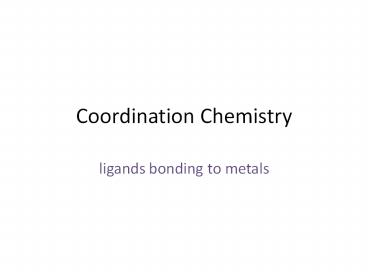Coordination Chemistry - PowerPoint PPT Presentation
Title:
Coordination Chemistry
Description:
... (en)2Cl2]Cl [Cr(H2O)4CO3]Br Isomerization in Coordination Compounds Do for octahedral Complexes Inner and Outer Spheres [Co(NH3)4Cl2]Cl H2O [Co ... – PowerPoint PPT presentation
Number of Views:2897
Avg rating:3.0/5.0
Title: Coordination Chemistry
1
Coordination Chemistry
- ligands bonding to metals
2
Donor-Acceptor Complexes
3
Definitions
Lewis Acid acceptor usually a transition
metal cation Lewis Base donor ligand
usually something with a lone electron
pair Coordination number of metal-ligand
attachments Denticity of attachments a
ligand makes
4
Common Ligands
Monodentate Ligands Halides F-, Cl-, Br-,
I- O2-, S2-, OH-, CN- NH3, H2O, CO
Bidentate Ligands
Polydentate Ligands heme, salen
5
Monodentate complexes
6
Monodentate complexes
7
Bidentate ligand complexes
Co(en)2Cl2
Ni(DMG)2
8
Bidentate complexes
Co(en)32
Fe(phen)32
9
Polydentate complexes
Co(salen)
chlorophyll
10
Fe-heme
11
Polydentate complexes
Fe-heme
O2-Fe-heme
12
Determining Metal Oxidation States
Ag(NH3)2NO3 K2NiCl4 Co(en)2Cl2Cl Cr(H
2O)4CO3Br
13
Isomerization in Coordination Compounds
- Do for octahedral Complexes
14
Inner and Outer Spheres
Co(NH3)4Cl2Cl? H2O
Co(NH3)4(H2O)ClCl2
15
All compounds
Structural (constitutional)
Stereo
linkage ionization hydration
geometric optical
Co(NH3)5ClNO2 Co(NH3)5NO2Cl
Co(NH3)4Cl(H2O)Cl2 Co(NH3)4Cl2Cl?H2O
Co(NH3)5SCN2 Co(NH3)5NCS2
16
Linkage Isomers
17
Ionization Isomers
18
Hydration Isomers
19
Optical Isomers enantiomers (mirror
images) key to recognizing no mirror planes of
symmetry Type 1. arrangement of monodentate
ligands Type 2. arrangement of bidentate
ligands
20
Geometric isomerism like cis-trans
21
Geometric isomerism
Fac- isomer
Mer- isomer
22
Geometric Isomers predicting numbers Use
shorthand M metal a, b, c, etc. are
different ligands Example 1 Co(NH3)4Cl2
23
Example 2 Co(NH3)3BrCl2
24
Example 3 Co(NH3)3enBr2































